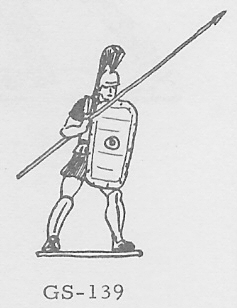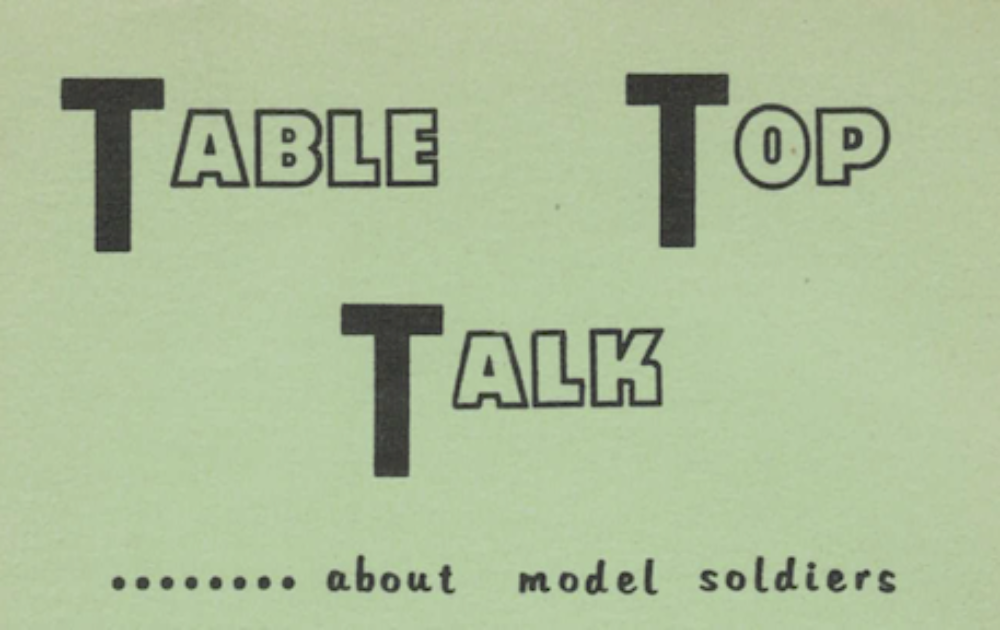Rules for a Roster System Ancient War Game
Photos and Text by Joseph Morschauser
Reprinted from: The Miniature Parade
Volume I Number II – winter 1967
On page 5 of this (winter 1967) issue of Miniature Parade Joe Morschauser describes an Ancient game setup he was working on at the time he wrote his article on the Roster System.
Since then, this army has been completed, and the results are pictured on the following page (editors note: click the links to see the pictures). This army consists of 160 (20mm) Scruby Miniature of the Greek warrior, advancing with pike, casting # GS-139 …

GS-139 as pictured in the 1967 Scruby catalogue
The pictures show the physical setup of the war game army on Joe’s 3ft by 3ft grid table, and the photographs are explained below. On the following pages we also duplicate the rules he uses for this game, which may be of interest to those who are looking for a “small” type war game of this period.
Explanation of the Photographs
Photo 1: Overall picture showing entire 3 by 3 foot table top board set up with terrain and 160 figures. Board is covered with green felt, edged with tape and lined with black ink marker in 1″ grid squares. 3/4″ tape (blue for rivers, tan for roads) is stuck on felt, can be removed with no damage. Village in center is made of 3/4″ pine wood painted white or gray, marked with felt tip marker (windows and doors) all mounted on basswood bases (3 x 3 inches) so form can be changed from game to game. Trees are model RR trees on bases, and HQ camps, seen at each end of board, are wood tent on base.
Photo 2: Medium shot showing units of Silver army attacking Gold army. Troops are mounted on 7/8″ photo mounting cardboard base painted green.
Photo 3: Attack in woods, town in background. All terrain and accessory features are slightly under-scale. On very small battlefield such under-scale features make movement of troops easier yet give desired effect.
Photo 4: Troops on a hill prepare to attack. 5/8″ plywood painted dark brown forms the hills. Layers (steps) of hills not fastened to each other so that different hill forms can be made of same pieces.
Photo 5: Meeting in the open. Units of troops are 8-men-strong, each unit having a different color helmet crest and skirt. Armor of one army is Silver, other Gold. Though appearing nearly the same (except for colored helmet crest) each unit has a different capability on Roster. Enemy commander does not know at start of game which units of opposing army are the fastest, most powerful in melee or best “shots” with javelins.
Photo 6: Edge of table. Table top is 1/2″ plywood; covered with green felt and edged with green tape. (Lower side of this table is in blue felt edged blue tape for use in naval war games with Scruby/Morschauser ships). Table top sits atop a card table, is not fastened down but the felt underside keeps it from sliding and the weight keeps it in place. The overhang is about 3″ on any edge as standard card table is 30″ square thus no tipping is possible by accident.
NOTE: The pikes of the Scruby casting has been shortened to provide minimum over-hang ‘into adjacent squares to avoid fouling with adjacent troops when moving. The base area of the game and headquarters to be captured are the HQ bases indicated in photo 1. Those who wish to enlarge their game can always add on more 3 by 3 foot plywood table tops.
~~~
Ancient Period: Concealed Strength Rules
By Joseph Morschauser
| Unit Types | Speeds | Melee Powers | Melee Range |
| A Class Unit | 6 Squares | 4 | The Square adjacent to the front of the man. |
| B Class Unit | 4 Squares | 4 | |
| C Class Unit | 6 Squares | 3 | |
| D Class Unit | 4 Squares | 3 |
Sequence of Play:
1) First throw missiles of all units of each side which the commanders desire to be thrown, removing losses only after both sides have thrown. Missiles are, thrown as men stand & face.
2) Now roll dice for first turn this, sequence. High man moves first.
3) First-turn-side moves all men, and then conducts melees. Then the Second-turn-side does the same. This completes the sequence.
Missile Rules:
1) Roll 1 dies for each man throwing missile. All men of a unit must, throw their spears during the same sequence and each unit may throw only once during the game. Put a check behind name of a unit on roster once it has thrown. SPEAR RANGE: 12 Squares.
a. Direct Fire: 2, 4, 6 is a hit, destroys one enemy.
b. Indirect Fire: 4 or 6 is a hit, destroys one enemy.
2) Range is counted off across sides of grid squares. If tray base can be seen from throwing man, use direct fire. If not, indirect.
3) Fire is simultaneous. If man is hit he, may still fire that sequence before removal if his entire unit fires. Men in melee contact (range) of enemy may not throw missiles or fire.
4) Arc of throw (fire) is 90 degrees forward, sweeping from one 45 degree diagonal line of squares to the other.
Movement Rules:
1) Each man may be moved only once per sequence. All moves’ are made across sides of, grid squares, never across diagonals.
2) A man may be moved through grid squares adjacent to flank or rear of enemy provided his own front does not face enemy during the move past that enemy man.
3) A man may not move through grid square adjacent to the front of an enemy man. He, must stop in that grid square, face the enemy, thus ending his move that turn. If he moves into a square faced by several enemies he may face any of enemy. Then he melees with that enemy man under the numbers VS, one rule. (See Melee Rule # 4)
4) A man facing or being faced by an enemy in an adjacent square at the start of his turn may break contact with the enemy and move away but he may not come into contact with another enemy in the process.
Melee Rules:
1) Melee contact is established when one mall faces an enemy in an adjacent square. A man may fight only one melee during his turn, that is he may attack only once during his turn.
2) When attacker moves into contact with flank or rear of enemy the latter is faced to meet him at once. If several attackers contact one enemy, enemy faces last attacker to come into contact. If attacker loses battle it is attacker’s man which faces enemy that should be removed.
3) If attacker is successful, remove defender at once. Then move the attacker whom defender faced into defender’s grid square if desired (optional). Even if this results in a new contact, the attacker may not conduct another melee attack this turn.
4) If several attackers assault on defender enemy, the defender’s melee power is reduced thus:
a. Two Attackers: Defender’s Melee Power reduced by 1
b. Three Attackers: Defender’s Melee Power reduced by 2
c. Four Attackers: Defender’s Melee Power reduced by 3
Melee Power used for several attackers is Melee Power of faced attacker. If the defender’s Melee Power falls below zero as a result of concentration of several attackers on him, he is simply removed without dice being rolled. This however constitutes a melee for the attackers involved.
5) The Melee Power of a man who is not in contact with one other member of his unit drops one point as long as he is not in contact. This drop’ takes place at once when contact is broken. Contact is defined as the adjacency of one grid square with the side or the corner of another. This is the only instance in these rules in which adjacency of grid square corners has any meaning.
Melee Conduct: Side taking (current) turn (Attacker) rolls one die for its man, a different colored die for the enemy man. Roll only once per turn…
a) Both dice show MP number pertaining or less; remove both men.
b) Neither dice show MP number pertaining or 1ess; stalemate, all stay put.
c) One die shows MP number pertaining or less, other does not; remove other.
Special Rules:
1) Hills:
a. Take one point of MP from attacker up 1 hill step, 2 MP up vertical (two-step). Take 1 point from defender vs. an attacker down 1 or 2 steps. Includes square adjacent to the base of the hill.
b. Two squares of move are used in climbing each step. Half square of move is used in descending each step. Odd half square on flat is lost.
c. Add three squares of range to any missile thrown down for each step it is above target. Take three squares of range from any missile thrown up for each step it is below its target.
2) Roads: Each square of move on a rod uses only one-half a square of a normal move. Standard move on off with half lost.
3) River: Three squares of move are used to cross’ a river for each square of river. Take two points of MP from an attacker attacking out of a river ford. Use same rules for swamps.
4) Towns: For movement, I towns are like roads. Take one point of MP from attacker into a town at edge. Once inside the attacker MP is normal vs. defender. Use indirect fire at target in a town. Use indirect when firing out of a town except at edge.
5) Trees: Take one point of MP from man attacking into woods. Once inside attacker’s MP is normal again. Use indirect fire when throwing missiles into, in, out of or thru woods.
